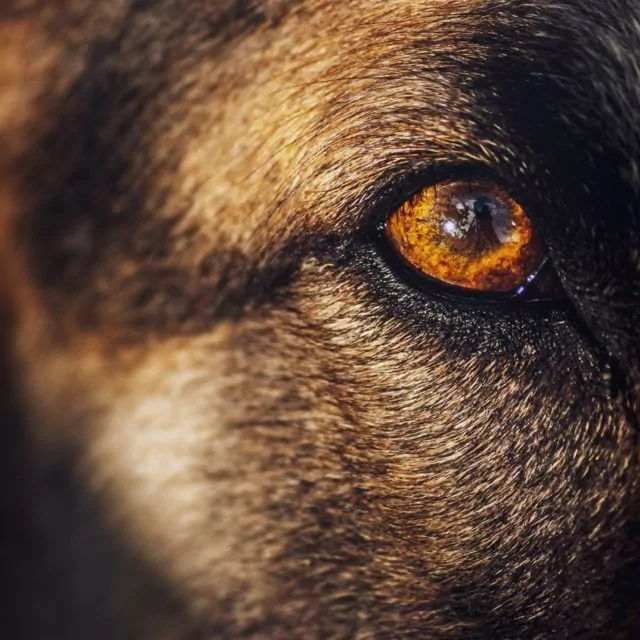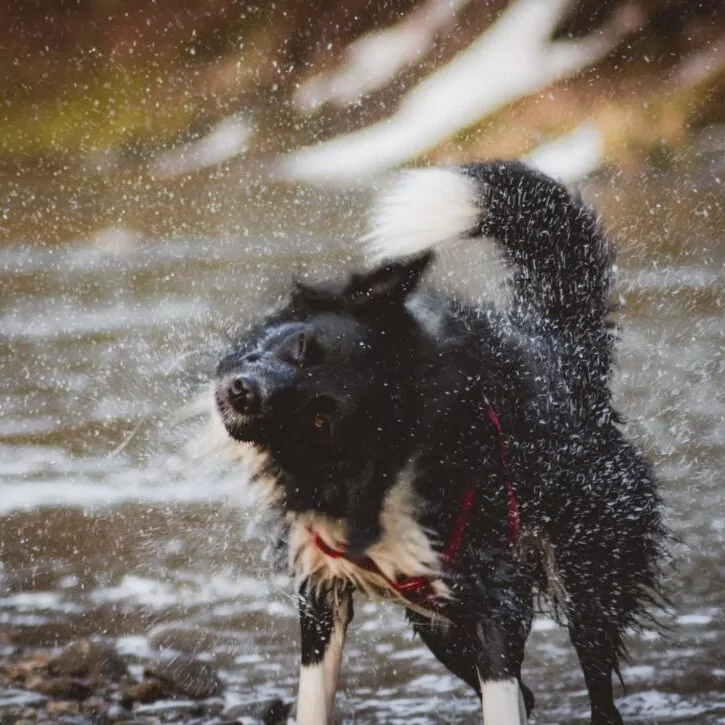Behavior & Symptoms
Why Do Dogs Have Whiskers?

They tickle our faces, quiver in anticipation, and communicate state of mind. They’re measuring devices and early warning signals. They enhance the senses of both touch and sight. And they’re cute.
What are we talking about?
Whiskers, of course. These multifunctional hairs, technically known as vibrissae—from the Latin “vibrio,” meaning “to vibrate”—help dogs navigate their lives in a multitude of ways.
“Whiskers are important for touch sensation and sensing in the dark,” says Amelia White, DVM, MS, DACVD, associate clinical professor of dermatology at Auburn University College of Veterinary Medicine in Alabama. “Many blind animals rely on their whiskers to avoid bumping into things. Dogs have skeletal muscles that attach near the whisker so they can voluntarily control movement of the whiskers.”
Whiskers fan out from each side of the muzzle (genal) and arch over the eyes (supraorbital). They can also be located above the lips—think mustache placement—known as mystacial whiskers. Long mystacial whiskers are classified as macrovibrissae, used for sensing what’s in the area around the head. Smaller mystacial whiskers that point downward, known as microvibrissae, serve to help identify objects. Beneath the chin, or snout, are the mandibular whiskers, referring to their presence along the lower jaw, or mandible. Collectively, they are known as cranial vibrissae.
Fascinating fact: The development of whiskers that could move was likely pivotal in the evolution of mammals, according to research from University of Sheffield presented in 2011 at the Society for Neuroscience conference. Whiskers allowed early mammals to integrate information from multiple senses—sight, sound, smell and touch—enabled them to hunt and move around in the dark, when dinosaur predators that might have feasted on them were inactive, and drove development of facial muscles and brain expansion and reorganization.
The thick, stiff, tactile hairs, meaning they’re involved in the sense of touch, are made of a tough protein called keratin, the same substance that makes up our own hair, fingernails, and toenails. While whiskers themselves contain no nerves, they spring from special hair follicles rich in sensory nerves. The bundles of nerves at the base of each follicle make whiskers exquisitely attuned to the surrounding environment. When whiskers brush up against an object, they vibrate, stimulating the nerves in the hair follicle. The resulting nerve impulses send information to the brain via the trigeminal nerve, which governs sensation in the face.
You might be surprised to learn that whiskers are a common area of study among neuroscientists studying sensory systems. That’s because a large part of the brain is involved in processing nerve impulses from vibrissae. Those nerve impulses first travel to the trigeminal sensory complex of the brainstem. They may then be directed to other parts of the brain:
- The thalamus, involved in relaying sensory signals;
- The barrel cortex, where neurons respond to whisker-related input and which plays a role in sensory processing and development;
- The cerebellum, which plays a role in coordination, precision, and timing;
- The superior colliculus, located in the mid-brain, involved with eye movement.
Among other things, researchers have found that, depending on the animal, whiskers may help them to find objects and detect movement. Writing in Psychology Today, psychologist and dog behavior researcher Stanley Coren, Ph.D., notes that in puppies, whiskers are among the first hairs to develop and that 40 percent of the area of the canine brain devoted to processing touch is associated with whiskers.
Whiskers are so sensitive that you may notice your dog flinching or closing her eyes if you reach out to touch them. One of the protective functions of whiskers, after all, is to warn dogs that something is approaching. The sensing range of whiskers is significant. Even very small movements can cause whiskers to respond.
A 2020 report in a German journal describes whiskers as part of a tactile sensory organ in a dog’s facial area. They are considered to be so sensitive and important to a dog’s ability to function that animal welfare laws in Germany, Austria, and Switzerland prohibit trimming them solely for appearance.
And it’s not necessary to trim whiskers, although groomers and dog show exhibitors often do it because it gives the dog’s face a neater appearance. It’s best to leave whiskers alone, Dr. White says, especially if you have an older dog or one with visual deficits.
“They have a very important role in helping animals sense where they are going, so cutting them short could cause them to bump into things, especially if they have poor vision,” she says. “Whiskers are specialized hairs, so they will shed on their own and be replaced by a new growing whisker when the normal growth period is over.”
How do whiskers help our puppers find their way in the dark or avoid other hazards? Changing air currents tickle the whiskers, indicating the presence of an obstacle or other animal the dog should avoid. Whiskers also vibrate as they touch a surface or object, transmitting information about its shape and texture. When whiskers come in contact with long grasses or other protruding objects, a blink reflex is triggered so the dog doesn’t get a poke in the eye. Whiskers benefit hunting dogs, who often must seek their quarry through dense brush. And whiskers pick up on vibrations made by running prey, helping dogs know which way to go.
Length and number of whiskers varies, but whiskers typically grow to be about the same length as the width of a dog’s head. Although it’s more commonly thought of as a cat behavior, some dogs may use their whiskers to help determine whether they can fit through an entrance. Of course, whiskers don’t grow wider with a dog’s body, so it’s still possible for them to become stuck if they rely on their whiskers to gauge whether they can fit into a spot.
Whiskers have another important function: communication. They tell us how our dogs feel. In play, whiskers pointing forward may signal interest in an object such as a toy. That dog may be getting ready to pounce on it. In another context, whiskers that are twitchy or flared forward may signal stress or agitation. Whiskers pulled smoothly back against the muzzle generally suggest a dog who is relaxed. Downward-pointing whiskers may communicate that a dog is feeling distressed or threatened. Twitching whiskers can also indicate a tense, alert dog. Sleeping dogs may twitch their whiskers while they’re dreaming.
If you’ve ever wondered how your dog is able to move her whiskers, it’s because the macrovibrissae have the aid of a small muscle “sling,” allowing each to move mostly independently. Larger muscles in surrounding tissue enable multiple macrovibrissae to move at the same time.
While all whiskers are slender, curved, tapered, flexible hairs that transmit vibrotactile information—in other words, the perception of vibration through touch—they don’t all look alike or even share the same arrangement on the face. Dogs, for instance, have a more scattered arrangement of whiskers on the face than cats, whose whiskers line up in four neat rows. Whisker color also varies.
Whisker color is related to a dog’s coat color, White says. Whiskers can be different colors, such as black on one side and white on the other or a blend of colors on each side of the face. White whiskers indicate a lack of pigment in that area of the body, while black or brown whiskers are found in areas of the face with an abundance of pigment cells. Whiskers may also change color, turning white as a dog ages, for instance.
The condition of whiskers may indicate age or health. They may become more coarse, brittle, or shorter in length as pets age.
“Diseases can also impact the normal texture, shape and strength of whiskers,” White says. “The most common change to whiskers with dermatitis is that they are prone to breaking. Ringworm is another example of a disease that can cause inflammation of the hair follicle and cause whiskers to spontaneously fall out or break.”
Whiskers are deeply embedded in the skin and don’t come out as easily as other hairs. In fact, the follicles from which whiskers grow extend about three times deeper into the skin than the follicles of normal hair.
We know of a veterinarian whose client brought in her dog because he had been quilled by a porcupine. She had been pulling the quills out but said it was too difficult and painful for the dog. It wasn’t quills she was removing but his whiskers! Ouch!
So be sure you recognize your dog’s whiskers. “Plucking a whisker hurts a lot more than plucking normal hairs, so don’t do it unless you are prepared for a swat or bite,” White says.
Did you find this helpful? Share it!
Questions for your Vet
- Should I trim my dog’s whiskers?
- Does it hurt dogs to trim their whiskers?
- Sometimes my dog’s whiskers fall out. Will they grow back?
About VetScoop
Pets make our lives better. At VetScoop, we’re on a mission to return the favor by giving you access to trustworthy, science-based information so you can provide the best possible care for your pets.
Related Articles We Think You'd Like





